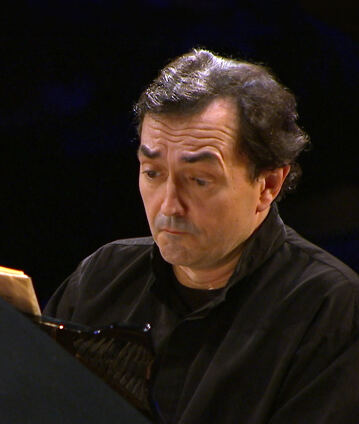“Late Night” concert with Pierre-Laurent Aimard

Charles Ives’s Concord Sonata is like a pianistic cosmos. There are intense lyrical moods, impressionistic dreams – and then again new sounds, sudden outbursts, and humorous quotes. All this adds up to a surprisingly coherent whole, a nocturne with avant-garde ambition. With dedication and sensitivity, Pierre-Laurent Aimard explores this multiform work.
Charles Ives’s Concord Sonata is probably the most monumental conceptual design of a piano sonata of the 20th century. The work’s world premiere by renowned pianist John Kirkpatrick in 1939 helped the composer, who until then was to a large extent unknown, achieve his breakthrough. As Ives explains in his extensive commentary Essay Before a Sonata, the spiritual world of the work, which lasts about 50 minutes in performance, is situated in the context of American transcendentalism, which experienced its heyday in the small New England town of Concord, Massachusetts between 1840 and 1860.
Four movements are dedicated to four outstanding figures of the antimaterialist and antirationalist movement. Time and again the main theme from Beethoven’s Fifth Symphony is quoted – music of the composer who more than anyone else stands for the large-scale musical project of the sonata. The second movement, a scherzo that not infrequently touches on the limits of what can be performed, reflects on utopian short stories by the writer Nathaniel Hawthorne – with sudden breaks like cuts in a film and motor rhythms with a ragtime inflection.
The last movement is dedicated to the nature mystic Henry David Thoreau, who himself played flute and, according to Ives, was a “great musician”. With its many-layered piano writing, often notated on three staves, the Concord Sonata achieves a complexity that confronts any interpreter with the greatest of challenges. Pierre-Laurent Aimard masters it brilliantly.
© 2012 Berlin Phil Media GmbH
Category
Artists
Our recommendations
- “Late Night” concert with Jörg Widmann
- “Late Night” concert with Simon Rattle
- “Late Night” concert with Simon Rattle and Stefan Dohr
- “Late Night” concert with Simon Rattle and Barbara Hannigan
- A “Late Night” concert with French chamber music and Simon Rattle at the piano
- “Late Night” concert with Sir Simon Rattle, Magdalena Kožená and Olaf Ott